AMD Ryzen 9 4900HS Review
Mobile calculating has become the side by side big target at AMD with its new serial of Ryzen 4000 APUs. The new processors volition arrive as the U-series for low-ability and ultraportables and the H-serial for high functioning laptops. Today we have the get-go retail Ryzen 4000 laptop on the market to evaluate, so the focus will be on the benchmarks, so we tin can encounter for the first time how Zen 2 brought across to mobile stacks upwards against Intel'south tried and truthful line-upwardly.
All Ryzen 4000 APUs are based on the Zen two architecture, congenital using 7nm engineering with a monolithic dice that also incorporates a Vega-based GPU. Earlier this month we published a full breakdown of Ryzen 4000 APUs, detailing some of its architectural features and specs. Nosotros'll skip nearly of those details in this review, simply you should definitely check that out for an overview of what else is coming in 2022.
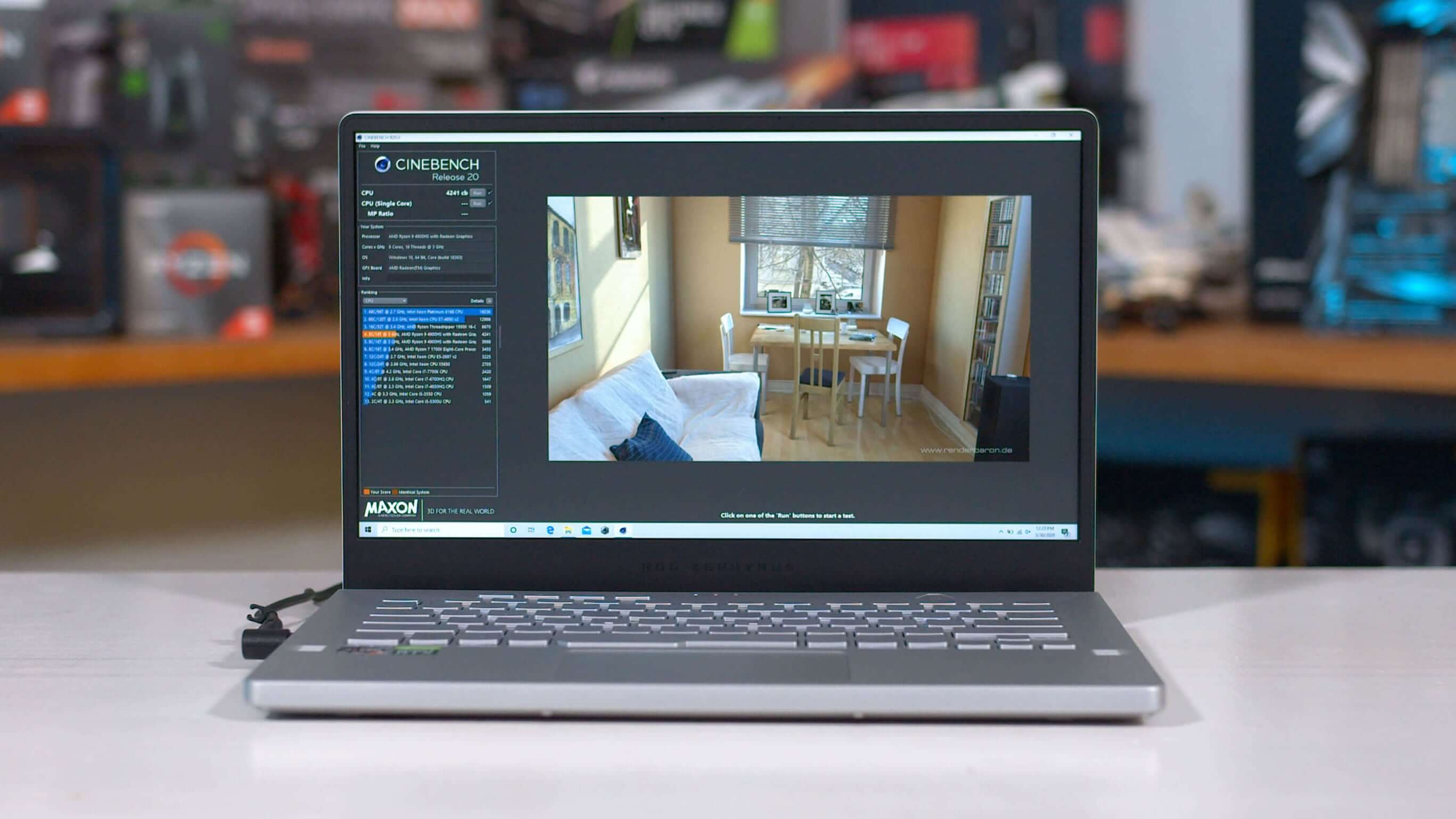
Only to exist clear, Ryzen 4000 parts do not utilise AMD's Zen 3 architecture. The naming is a niggling confusing here – Ryzen 3000 for Zen two desktop chips, and Ryzen 4000 for Zen 2 APUs – but this is just a continuation of what AMD started in 2022 when they launched the first Zen APUs as Ryzen 2000. Ryzen 4000 APUs are thus based on Zen two cores, same every bit the latest Ryzen desktop CPUs.
It's no coincidence Ryzen Mobile U and H serial mirror what Intel offers for different types of laptops. With ultraportables release still awaiting, today is all most the powerful H-serial and how AMD will fare for content cosmos, productivity and gaming.

AMD'south Ryzen 4000 H-series consists of 3 singled-out SKUs: the Ryzen 5 4600H delivers 6 cores and 12 threads for the mainstream, the Ryzen 7 4800H bumps that up to 8 cores and 16 threads, aslope a higher-clocked viii-core variant in the Ryzen nine 4900H. All of these APUs come with a 45W TDP, and are complemented by a depression power 35W variant for laptops that also adhere to the rest of AMD's HS-series design guidelines.
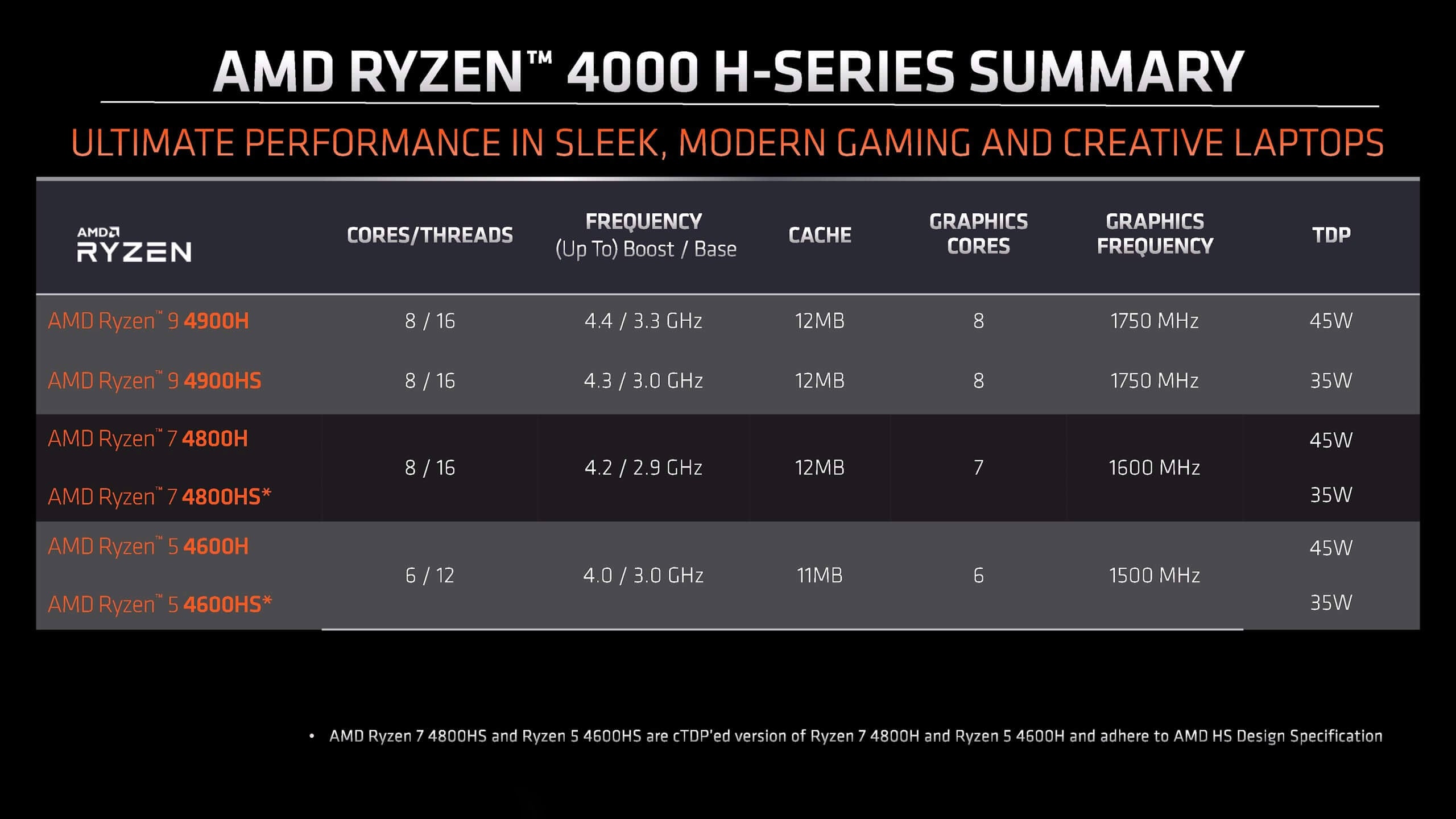
You'll also find dissimilar GPU configurations for each SKU, using the refreshed Vega blueprint with up to 8 compute units and higher clock speeds. Interesting to note, but we'd expect nearly H-series laptops to also include a discrete GPU, like our test arrangement. Cache, while listed at 12 MB, is actually a combined L2 and L3 effigy: all parts take 8 MB of L3 enshroud, Ryzen vii and 9 go 4MB L2, and Ryzen 5 gets 3MB.
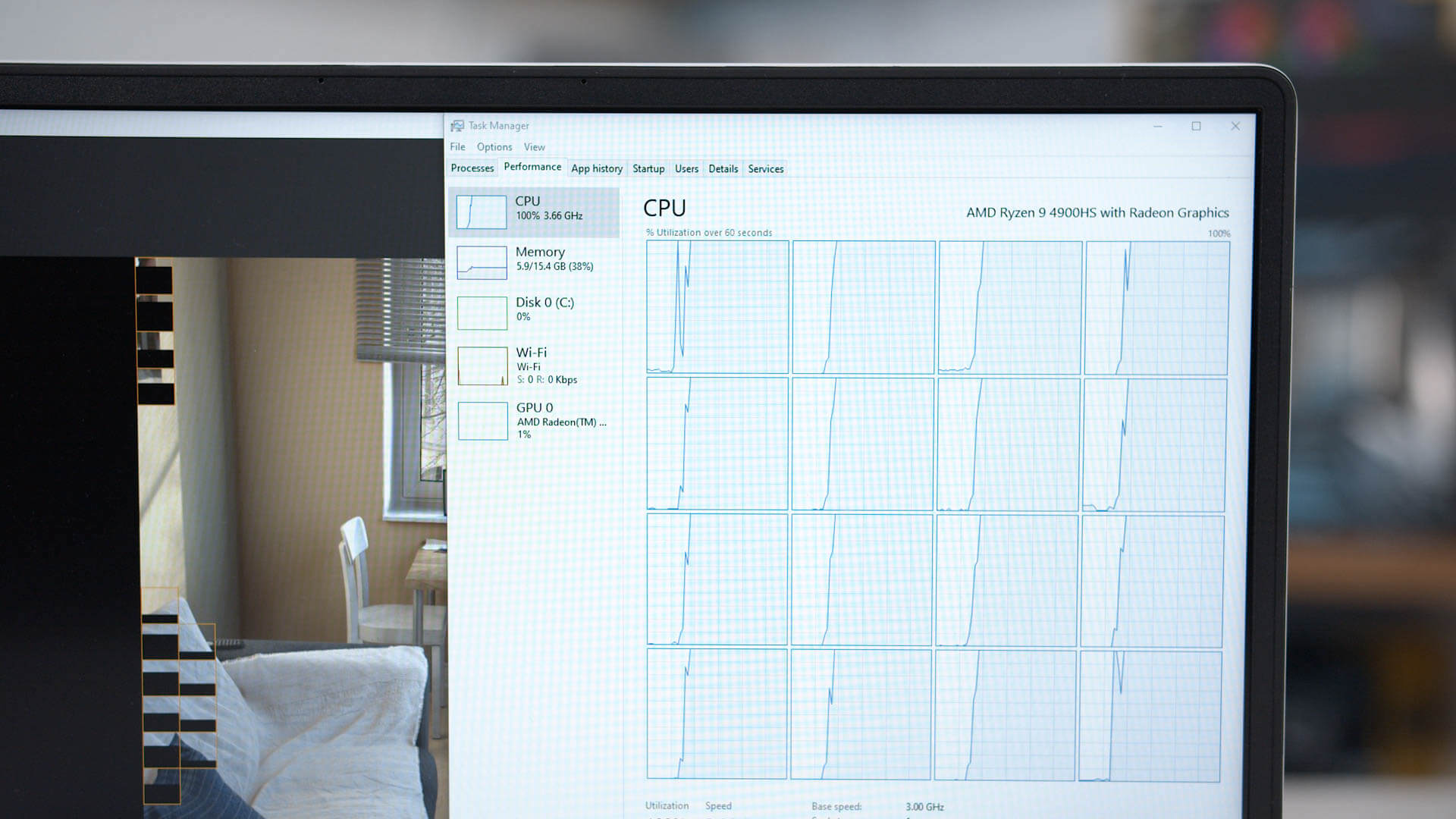
The fleck we're benchmarking today is the Ryzen 9 4900HS, a 35W SKU that provides slightly higher base and boost clock speeds than the Ryzen 7 4800H that sits below it at 45W, a fleck of binning magic at play there. It'due south not the outright flagship APU in AMD's line-upwards, just information technology will give u.s.a. a actually solid look at Ryzen 4000 performance. We'll also give you a sneak summit of Ryzen 7 4800H functioning from an technology sample, as we look to review the rest of processors in the line-up equally new laptops brand it to market.
Our benchmark testbed is the Asus Zephyrus G14, a cracking portable 14-inch gaming laptop that packs in Ryzen 4000 HS APUs and up to GeForce RTX 2060 Max-Q graphics. We received the highest-spec model for testing, with the RTX 2060 Max-Q and the 4900HS, 16 GB of DDR4-3200 memory and a 1080p 120Hz display.
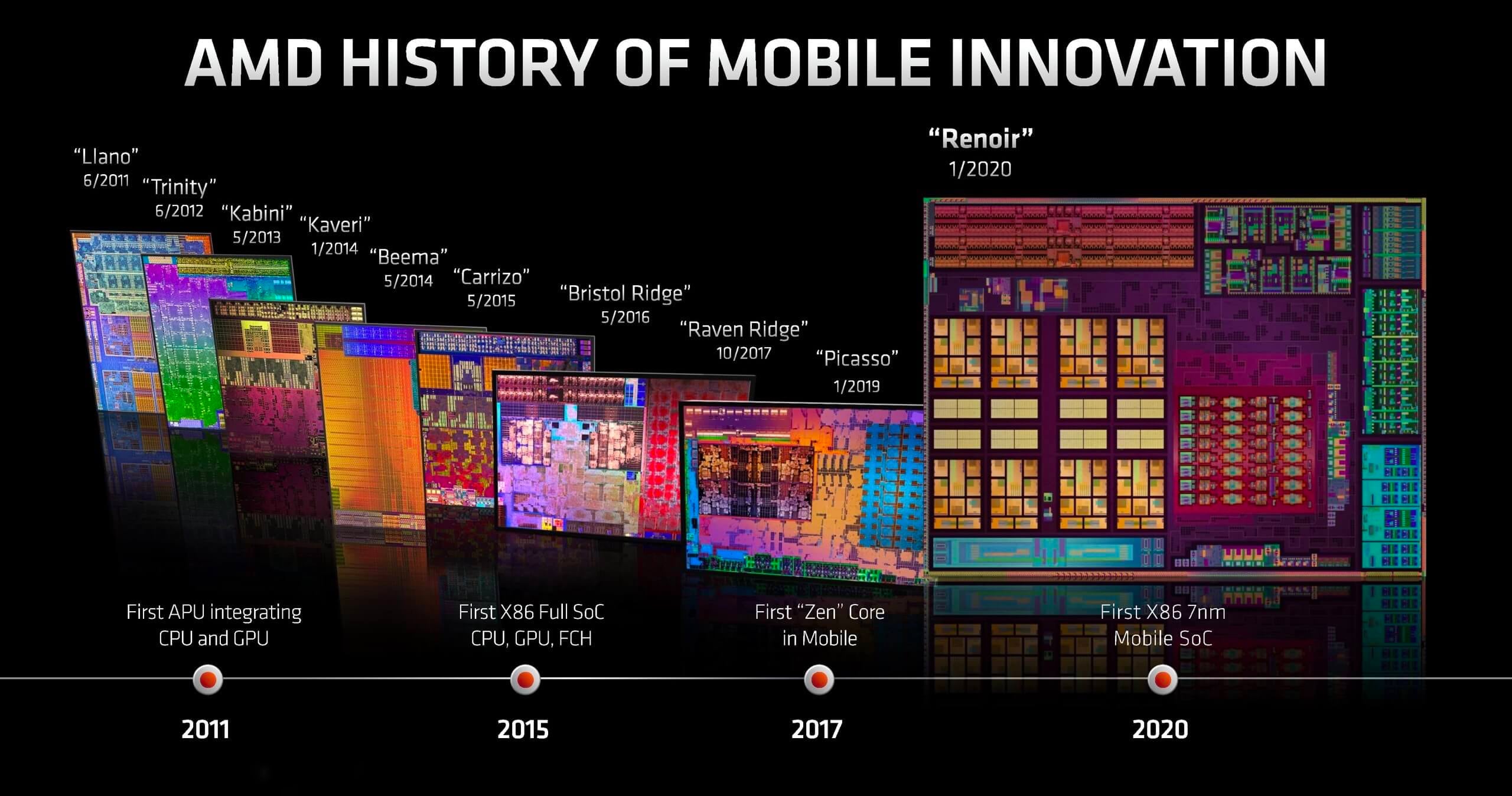
The focus on this review is purely CPU performance, so we won't go into the design and other features of the Zephyrus G14. We will say this though, after a calendar week of use we think it's a very well built laptop, with a great keyboard and every bit we're almost to see, very compelling operation in such a pocket-size form factor.
You'll also run across across this review a number of dissimilar laptop CPUs in the charts and, at times, GPU configurations as well. The data in the charts is an average from the laptops we've tested with the given hardware. Testing laptop components is naturally a fleck more difficult than desktops as each configuration can vary in cooling and other hardware, then these averages are meant to illustrate how a 'typical' system will perform. The averages do not include single channel memory systems or any other situations that heavily throttle the components at manus, we've tried our best to create apples-to-apples data where possible.
Benchmarks
Let'due south kick things off with a classic operation benchmark: Cinebench R20. In this test we encounter total domination by the red squad. Not only is the 4900HS the fastest laptop processor we've tested in the multi-threaded workload, it's also the fastest in unmarried-thread performance. The 4900HS is 35% faster than the eight-core Cadre i9-9880H when using all cores, and 7% faster in single-cadre. In that location is the Core i9-9980HK that we haven't tested that might put upwards a flake of a fight, but the 90W numbers from the 9880H suggest this might be a hard task. Also consider, these results are from the lower-TDP 4900HS, the 4900H at a full 45W should be another step ahead.

In that location are other vicious results in this Cinebench nautical chart. The 4900HS crushes the Core i7-9750H, which is the most popular CPU used in slim and light gaming notebooks. Zen 2 offering is over threescore% faster in the MT test. We also run into the previous-gen AMD part become a bit humiliated, the 4900HS is so much faster than the Ryzen 7 3750H in the aforementioned power envelope it's non funny.

We likewise tested with the legacy Cinebench R15 which has results from a wider range of CPUs going back more years. The 4900HS remains firmly placed at the acme of the charts as expected. Anyone upgrading from a Core i7-7700HQ, for example, which was a popular H-series CPU in 2022 volition exist treated to more than double the performance with a Ryzen nine 4900HS.

Ane area where Zen 2 receives a specially large upgrade is in how it handles AVX-256 instructions. It's just much faster at wide floating betoken operations than before. And then the Ryzen 9 4900HS receives an enormous performance upgrade in our Handbrake x265 exam, which uses AVX instructions. The 4900HS is a monstrous 179% faster than the 3750H in this workload, which is just unfathomable for a single generation performance leap.
On an AMD vs Intel front, it's as well highly favorable for AMD. Not quite the aforementioned margins as we saw in Cinebench, just nosotros yet run across a 23% operation advantage of the 4900HS over the 9880H, and a 45% advantage over the 9750H. Frankly, these are massive deltas for a laptop form factor that oftentimes receives single digit gen-on-gen improvements.
For Intel to match the 4900HS with its 8-core offering, it needs to blow its power target out the window and instead employ a 90W TDP, which is possible on some gaming laptops with a 'Turbo' manner or similar. The difference in ability draw at the wall for these ii systems is incredible: the G14 with the 4900HS ran comfortably at effectually 66W long term, compared to 150W for the power boosted 9880H in our HP Omen 15 test system. That merely goes to show how much more efficient AMD's Zen 2 pattern is at these long term workloads.

Blender tells us a similar story, with huge performance gains in the ~35% range for the 4900HS over the 9880H, and ~65% range for the 4900HS over the 9750H. Most Blender users will probably render on the GPU instead since it tends to exist much faster, merely it's some other benchmark that illustrates long term multi-core functioning on these laptops.

In terms of decompression, we see AMD pull away with a significant victory in 7-Zip. Ryzen processors are known to work very well in this workload. However it does fall behind the 9880H in terms of compression, to the tune of ~viii%, although AMD beats lower core count parts like the 9750H.

Adobe Photoshop performance is interesting. In our Iris Blur examination which is mostly CPU limited, the 4900HS manages to beat the 9750H but falls behind the 9880H, sitting comfortably between those two processors.

This continues to be the example in the more comprehensive Puget Photoshop benchmark, which runs through a range of tests. In both of these workloads, which apply various effects to very high resolution images, the 4900HS is around ten percent slower than the 9880H in a core-for-core boxing. Granted, nosotros are seeing twoscore% college operation than AMD's last-gen APUs.

Now let'southward check out PCMark 10 numbers. We're looking at the Essentials and Productivity workloads as they're CPU limited, whereas the rest of the tests rely more on the GPU.
The Essentials workload covers things like app loading, web browsing and video conferencing. AMD manages to match the performance of the 9880H, which may non sound all that impressive, until you realize that the last-gen 3750H gets slaughtered in this test. Now AMD is at operation parity for these everyday workloads.

On the Productivity workload we see something similar as before, with the Ryzen 9 4900HS outperforming something similar the Core i7-9750H. These sorts of tasks were less than decent on previous Ryzen, so fifty-fifty though Ryzen 4000 isn't crushing Intel hither, performance parity is a adept result.

However at that place are some situations with productivity workloads where Ryzen 4000 isn't as impressive. Our custom Excel benchmark features a lot of number crunching on a big dataset, and hither that the 9880H outperforms the 4900HS again. The 4900HS is faster than the 9750H, so it'southward non a terrible result by whatever means, but it does seem that big dataset workloads are a weakness for Ryzen.

MATLAB lets us reconfirm this with our ODE and FFT benchmarks. Again, lots of data crunching on large sets of data and Intel'southward 9880H walks away with a victory.

Another workload where Ryzen performs well, but not enough to beat Intel'south eight-cadre competitor is our Acrobat PDF export test, which is fully single-threaded. The 9880H is marginally faster in Acrobat, although we nevertheless see a significant performance increase for the 4900HS over the 3750H with a healthy 20% bump to single-threaded operation.

1 final workload before we look at GPU dispatch is AES-256 performance as provided by SiSoft's Sandra benchmark. In the multi-threaded examination, we see xv% college AES performance from the 4900HS versus 9880H to make it the fastest CPU nosotros've looked at for cryptography workloads. This gives Ryzen a neat advantage in two heavily utilized low-level tasks in decompression and cryptography.

Now permit's work through our Premiere tests which are mostly GPU accelerated, starting with our 1 pass encode which takes reward of Intel's QuickSync technology. Premiere does not support hardware accelerated encoding on AMD processors at this stage, and then for those that like a quick consign with slightly reduced image quality at the end, Intel is withal the mode to go. In detail, the 4900HS paired with Nvidia's GeForce RTX 2060 Max-Q is ~20% slower than a Core i7-9750H with an RTX 2060 simply because hardware acceleration is not available.
On the other paw, our Core i9-9880H system doesn't support QuickSync acceleration as the iGPU is fully disabled to support G-Sync through the Nvidia GPU. So we are left with a squeamish software encoding comparing between the 9880H and 4900HS, where the 4900HS pulls away strongly to the melody of 26%.

And so we go to our two pass encode which produces superior image quality and doesn't support hardware acceleration. In this scenario, performance falls back to what we saw from well-nigh long-term workloads: the 4900HS is thirty% faster than the 9880H, and 38% faster than the 9750H, despite our 9880H laptop packing a much faster GPU. This test isn't GPU limited simply even with a moderately capable discrete GPU it appears equally though AMD's Zen ii APU is significantly faster for Premiere encoding.
But wait, at that place's more than Premiere tests. Here nosotros have a single instance of Warp Stabilizer, which is a hugely enervating effect that runs on a single thread per instance. The 4900HS manages to stabilize the footage fourteen% faster than the 9880H, and 22% faster than the 9750H, which shows the power of the loftier unmarried-thread performance nosotros outset saw with Cinebench.



And finally we have the Puget benchmarks. The Ryzen nine 4900HS is the all-time laptop CPU for alive playback in Premiere, performing 12% better than the 9880H, meaning we're seeing better editing operation. So for their export benchmark, we meet similar numbers to what we've simply been talking about, with QuickSync acceleration assisting with some of this workload.
Gaming Benchmarks
While we don't think many people will really be using the integrated GPU in these H-series processors given the vast majority of H-series laptops also include discrete graphics, it's worth a brief look at how the iGPU fares in a small selection of low intensity games, just to see what improvements AMD has made to the Vega GPU.
The Ryzen 9 4900HS sports the fastest iGPU configuration available in the series with 8 compute units clocked upward to 1,750 MHz. And it does deliver impressive results. In Chiliad Theft Auto V, the 4900HS delivered 36% more performance than the Ryzen 7 3750H, which featured 10 Vega compute units at 1,400 MHz. On newspaper, both CPUs have similar raw GPU performance, merely with all the advantages AMD talked about like increased retentivity bandwidth, this new Zen 2 APU is able to pull ahead.


In Civilization VI, the 4900HS again provides 37% more than operation than the 3750H within the same 35W power envelope. And moving to CS: Go, that margin remains identical at around 37%. The 4900HS running CS Become exclusively on the integrated graphics was able to accomplish over 100 FPS on boilerplate using depression settings, which is very squeamish.


And so finally we have our most performance-intensive iGPU test in Gears 5 running at Medium settings. The 4900HS is around 31% faster than the 3750H in this workload, which makes it faster than a low-end detached GPU offering similar Nvidia's MX250.
Information technology's not mutual to come across an H-serial laptop paired with an MX-class GPU. Normally OEMs opt for more powerful configurations like a GTX 1650 or college, but with Ryzen 4000 there's really no need to carp with an MX250 or similar detached GPU in an H-series type design.
Sustained Clocks and More Questions
At this point in the review we'd normally walk you lot through some comparison summaries between the Ryzen 9 4900HS and various other CPUs. But we notwithstanding think there'south a few operation questions left on the table. One is what clock speeds the CPU actually runs at in practice, and how boost behaves. And the other is, why do nosotros run across lower operation in some data heavy workloads like Matlab, Excel and Photoshop. Then allow's tackle this second part first.
We accept two working theories every bit to why we see information heavy workloads perform this way. The commencement is a uncomplicated 1 based on the specifications of these processors, in detail cache sizes. The Core i9-9880H has a decent 16 MB of L3 cache, which matches what Intel offering on the desktop with parts like the i9-9900K. However the Ryzen ix 4900HS has only 8 MB of L3 cache, one-half of what Intel offers, and well below the 32 MB of L3 that AMD packs into their viii-core Zen 2 desktop processors similar the Ryzen 7 3700X.

Having less cache means less data can be stored in super fast retentiveness and accessed in an instant. When yous have high core count, high operation CPU cores but non enough cache, this can get a bottleneck in some instances. And while this enshroud amount has doubled on Ryzen 4000 from previous mobile series, then has the core count. Information technology'due south probably not the whole story, but definitely part of it.
The other is the memory system. Yes, AMD offers higher memory bandwidth than Intel with the motility to support DDR4-3200 speeds, Intel only offers DDR4-2666 with 9th-gen. In a benchmark similar Sandra nosotros see AMD providing around 35% more memory bandwidth. However, Ryzen 4000 appears to have junior memory latency. This, like cache size can go a operation constraint. The Core i9-9880H has retention latency effectually 30ns for data sets above 32MB in size, while the Ryzen 9 4900HS has 46ns retention latency. That'southward a substantial win for Intel.
It's hard to say for sure whether these factors are part of the crusade, or the entire cause, merely looking through low level benchmarks these were the two things that stood out to us. When we get to benchmark more Ryzen 4000 APUs we'll go a clearer picture of where these bottlenecks prevarication.

Equally for clock speeds and heave behavior, permit's take a look. From a common cold kickoff in our Handbrake AVX workload, the Ryzen 9 4900HS consistently boosted upwards to around 65W of power for a few seconds achieving four GHz boost clocks all core, before dropping down to 54W for a longer sustained period, with clocks around 3.7 GHz. Somewhen the CPU settles down to 35W to provide three.two GHz all-core, but in a higher place this processor'southward three.0 GHz base of operations clock. The boost period can vary depending on how warm the arrangement is, just from a cold kickoff we were generally seeing at to the lowest degree ii minutes of ~53W heave which is generous. Temperatures were actually very well managed on the Zephyrus G14, with its air cooler providing a tick over 70C sustained, but of grade, this will vary between laptops.
Performance Summary
Ryzen 9 4900HS vs. Core i9-9880H
The big one hither is the Ryzen 9 4900HS versus the Cadre i9-9880H. These are similar grade processors, viii-cadre versus eight-core and should give us a pretty solid indication of what to wait from 10th-gen also, if we go minor clock speed improvements from Intel every bit is rumored.
In almost long term, multi-threaded workloads, we're seeing 35% better functioning from the Zen 2 chip. We also get impressive numbers for video encoding. Single-threaded workloads are too typically faster, or in the worst case scenarios like light productivity, equivalent to Intel's. However, operation does autumn behind in data heavy benchmarks similar Excel, Photoshop and Matlab.

The amazing thing well-nigh most of those results is AMD is able to achieve, in many workloads, at least 25% better multi-thread performance while besides coming in with lower sustained ability draw, at 35W versus 45W. So what happens when you limit Intel's 9880H to a PL1 of just 35W using Intel'southward XTU software?

Well, the margins abound even more. While we practise allow these processors do what they ordinarily do in the boost stage, some benchmarks don't change too much, long term workloads at present are strongly in favor of AMD. Over 50% better performance in some situations is possible, and a 40% improvement to Handbrake is impressive. This means that an OEM designing a slim and low-cal system with limited cooling will generally go the best experience past far going with Ryzen.

Amazingly, fifty-fifty when nosotros throw Intel'southward 45W power limit out the window and boost up to 90W forever, Intel all the same tin't beat the 35W AMD processor in long term multi-thread workloads. In an astounding win for efficiency, the 4900HS is either equal to this 90W processor configuration, or upward to fifteen% faster. With these two systems going at information technology, we observed an 80W ability describe deviation from the wall, so if Intel wants to match AMD with 14nm CPUs by just raising power limits, laptops will need much larger coolers to cope.
Ryzen ix 4900HS vs. Core i7-9750H
Comparing the 4900HS to the 9750H, there's only one instance where the 9750H system tin be faster, and that's with QuickSync accelerated Premiere encoding. In every other benchmark, including those where previously the 9880H was faster, now the 4900HS is faster. This bodes well for any future battles in the Ryzen vii/Core i7 range where AMD has a core reward in offer exclusively viii-cadre parts.

Ryzen 9 4900HS vs. Ryzen vii 3750H
Now let's look at how far AMD has come with Zen ii vs. Zen+ in a 35W mobile design. The difference in certain workloads is staggering. Not only is AMD producing a 30% operation improvement in unmarried-thread workloads, they're able to deliver ii.5x the functioning in long term multi-thread tasks like Blender, Handbrake and Cinebench -- with the same power depict.

Ryzen 9 4900HS vs. Ryzen 7 4800H
We did promise a sneak peek at Ryzen 7 4800H performance on an engineering sample laptop we had brief access to. Going on a modest subset of benchmarks, performance is looking equal to, if not slightly meliorate, than the 4900HS, which bodes very well for more mid-range systems that will use the Ryzen 7 part. Yes, the 4900HS is more than efficient, only the 4800H should still deliver pure 8-cadre performance.

What We Learned
Ryzen 4000 is delivering the best operation for heavy productivity workloads you can get in a mobile class factor. We can say that without even testing the higher power Ryzen 9 4900H, considering the 35W variant in the Ryzen 9 4900HS is already leaving Intel's 8-core competitors in the grit.
The Ryzen nine 4900HS is a groovy option for core-heavy work: we're talking video encoding or transcoding, 3D rendering, file compression, that sort of thing. It's much faster and does and so at a lower power draw, allowing for amend performance in a smaller form factor. Even in single-thread workloads, AMD generally comes out on tiptop, which ways that the Premiere editing experience is better on the Ryzen 9 4900HS, for example.
From a pure gen-to-gen upgrade perspective, AMD has done an amazing job. The Ryzen vii 3750H was difficult to recommend and information technology was handily beaten past Intel'due south mid-range parts. That has all changed with the newer APUs.
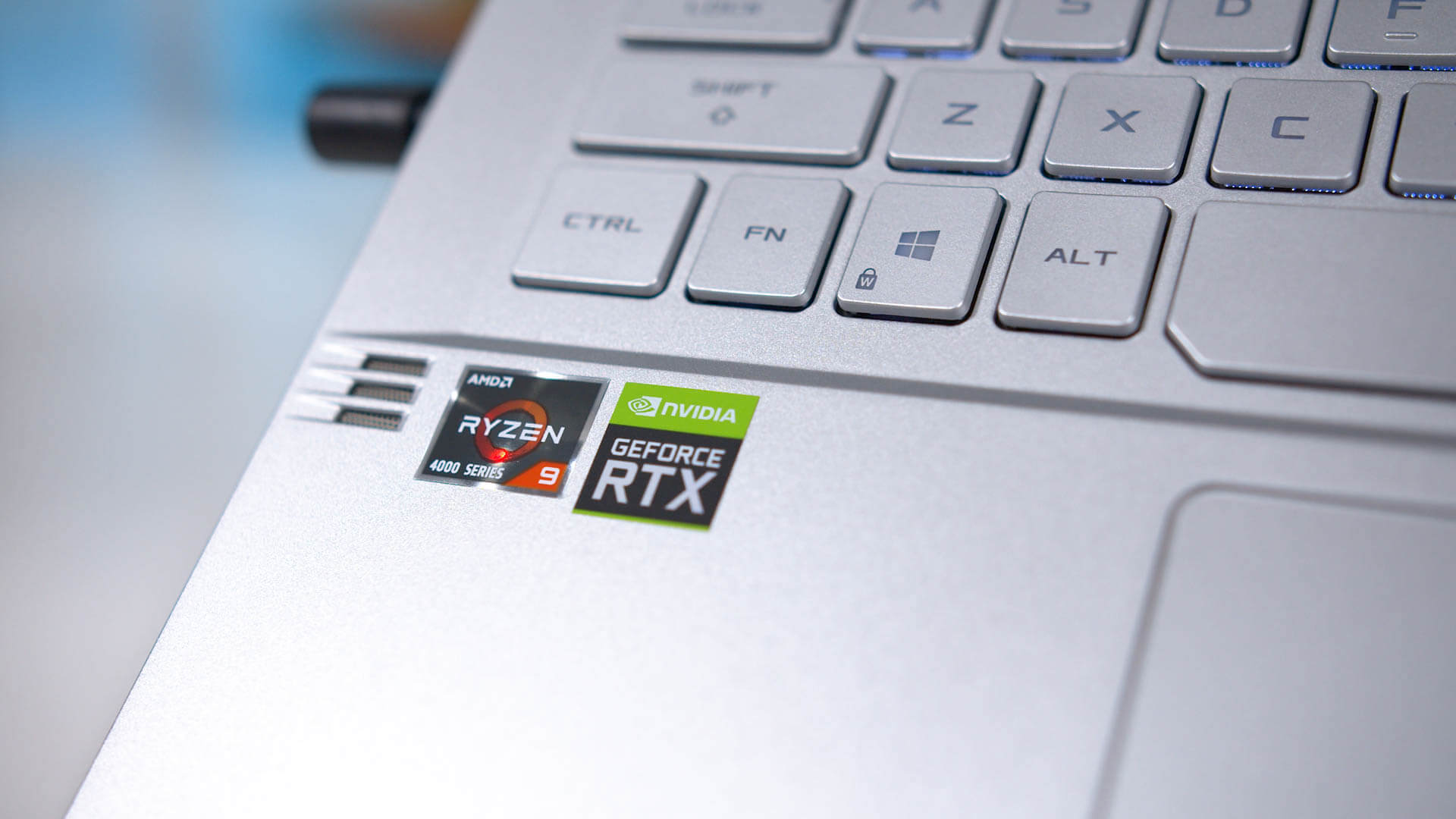
Technically, Intel parts tin withal compete on the performance front end if yous remove the 45W long term power limit. We saw that with the Cadre i9-9880H and nosotros await it'd exist similar had we tested the flagship Core i9-9980HK. Merely to get that sort of performance, you lot need a larger laptop with a beefier libation, and it'll likely run hotter, too. The Ryzen 9 4900HS can provide all that performance in smaller laptops -- like this Zephyrus G14 -- and run cooler at the same fourth dimension.
However, AMD'southward Ryzen 4000 CPUs aren't the complete bundle, there are a few limitations. One is with data heavy workloads, similar number crunching massive spreadsheets in Excel, working with huge photos in Photoshop or running Matlab scripts. Intel came out alee in these tests. Lighter loads will do simply fine on AMD, but if you're a big number cruncher, Intel's cadre-equivalent processors might be the fashion to get.

The other is with workloads that use Intel exclusive technologies like QuickSync, Premiere encoding existence one. If that's something you use all the fourth dimension, Intel is the way to go. It'south worth mentioning that every other task in Premiere outside of QuickSync encoding is faster on Ryzen 4000, including editing and applying intensive effects like the Warp Stabilizer.
Outside of those two instances, you'll take a amend, faster productivity experience with these Ryzen 4000 8-cadre processors. That'due south uncharted territory for AMD on a mobile PC grade cistron.
Also it seems that AMD will be offering this sort of operation at very competitive prices. The Zephyrus G14 with the Ryzen 9 4900HS and RTX 2060 Max-Q is fix to retail for about $one,500, which is firmly the territory of six-cadre Core i7-9750H laptops. The Core i9-9880H laptop we bought for testing in this review cost $2,400 and was i of the least expensive we could notice. Granted, it does take a much faster GPU for gaming, but right now you only won't find 8-cadre laptops in the $1,500 price range. While almost of our data has been focusing on Ryzen 9 vs Core i9, they don't really compete caput to head on pricing, at to the lowest degree for now as this could change with Intel'south 10th-gen.
A few additional notes to wrap up this review...
With previous Ryzen laptops nosotros didn't have the almost stable experience, running into plenty of software bugs and crashes, which we've discussed a few times before. Completely different feel with the Ryzen 9 4900HS in the Asus Zephyrus G14. Fifty-fifty with a beta version of the GPU driver on this laptop, we ran into no stability issues, crashes or applications refusing to work correctly.

Y'all likewise might be wondering about gaming functioning with a discrete GPU. The Zephyrus G14 does include the RTX 2060 Max-Q after all. That'southward something we'll explore in a future review every bit nosotros're withal working to get the best apples to apples comparison. Hoping to accept that shortly.
Battery life volition as well be on people's minds, but information technology's not something we ready out to examination as we didn't have enough data for various laptops to make information technology a fair comparison.
Finally, nosotros'll close this one out with some comments on Intel's 10th-gen. The new laptop CPUs are coming merely effectually the corner, likely within a month. Rumors suggest Intel is sticking with viii-cadre parts for the H-series, and are still using 14nm engineering. Nosotros just can't run across how they tin can compete on a functioning or efficiency level. If all nosotros're getting is a small clock speed bump with the aforementioned 14nm efficiency as the final few generations, Ryzen is going to easily win this one. We'll see that battle unfold soon, but based on what we've seen so far, we don't hold high hopes for 10th-gen.
Shopping Shortcuts
- Asus Zephyrus G14 on Best Buy, Amazon
- AMD Ryzen 9 4900HS Laptops on Amazon
- Nvidia RTX 2060 Max-Q Laptops on Amazon
- Nvidia GTX 1650 Max-Q Laptops on Amazon
- Core i9-9880H Laptops on Amazon
- Cadre i7-9750H Laptops on Amazon
- Core i7-10710U Laptops on Amazon
Source: https://www.techspot.com/review/2003-amd-ryzen-4000/
Posted by: washingtonthandrell.blogspot.com


0 Response to "AMD Ryzen 9 4900HS Review"
Post a Comment